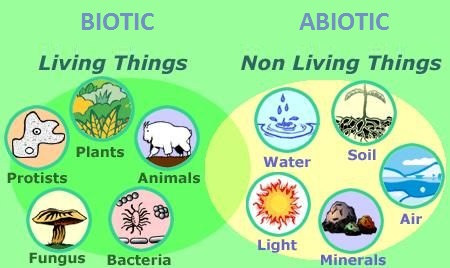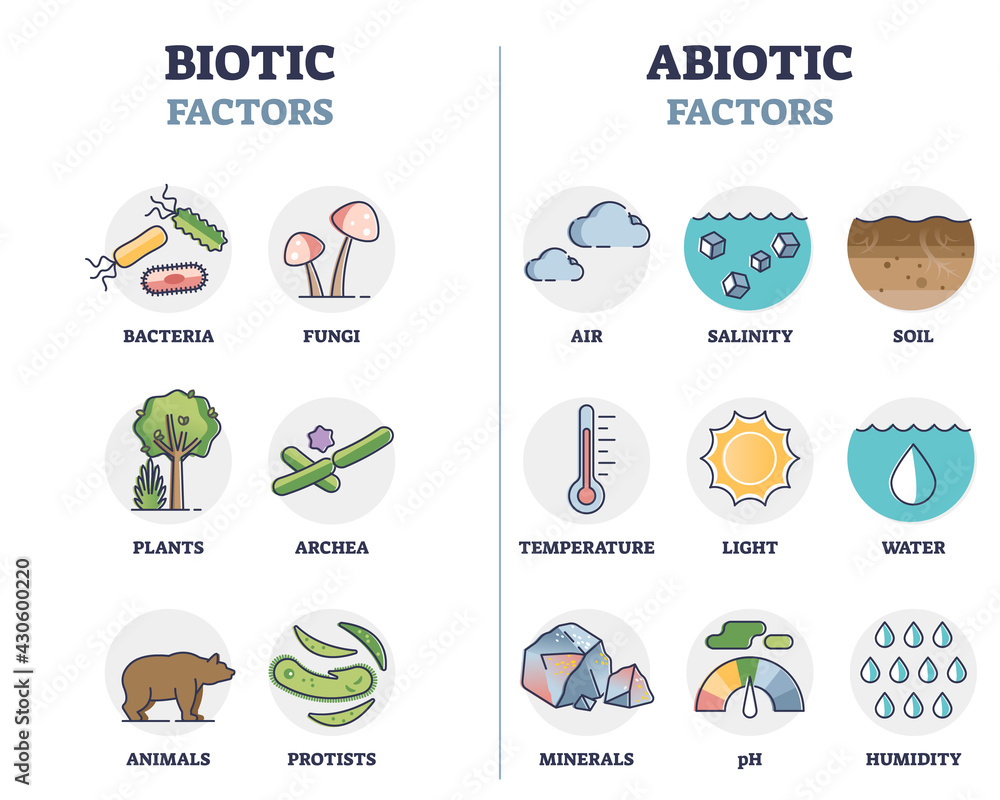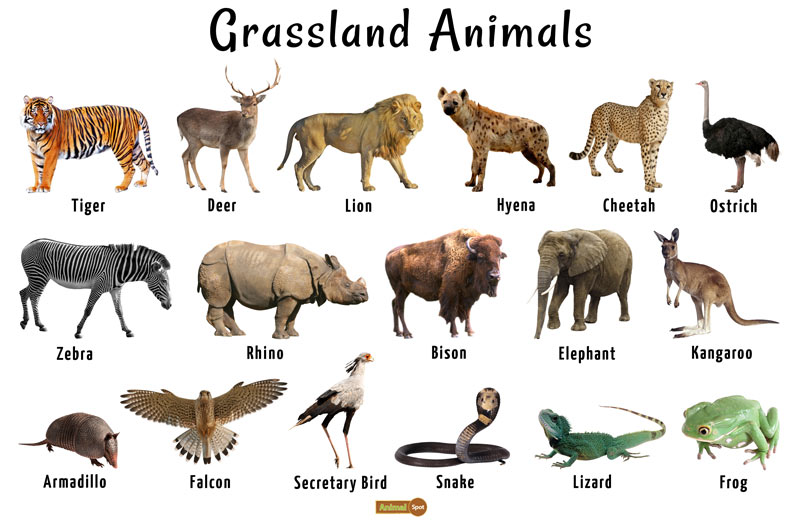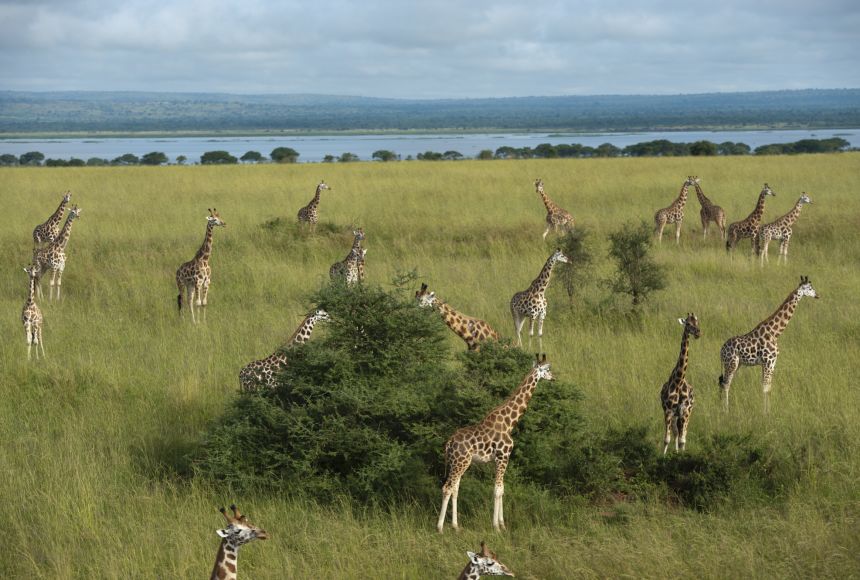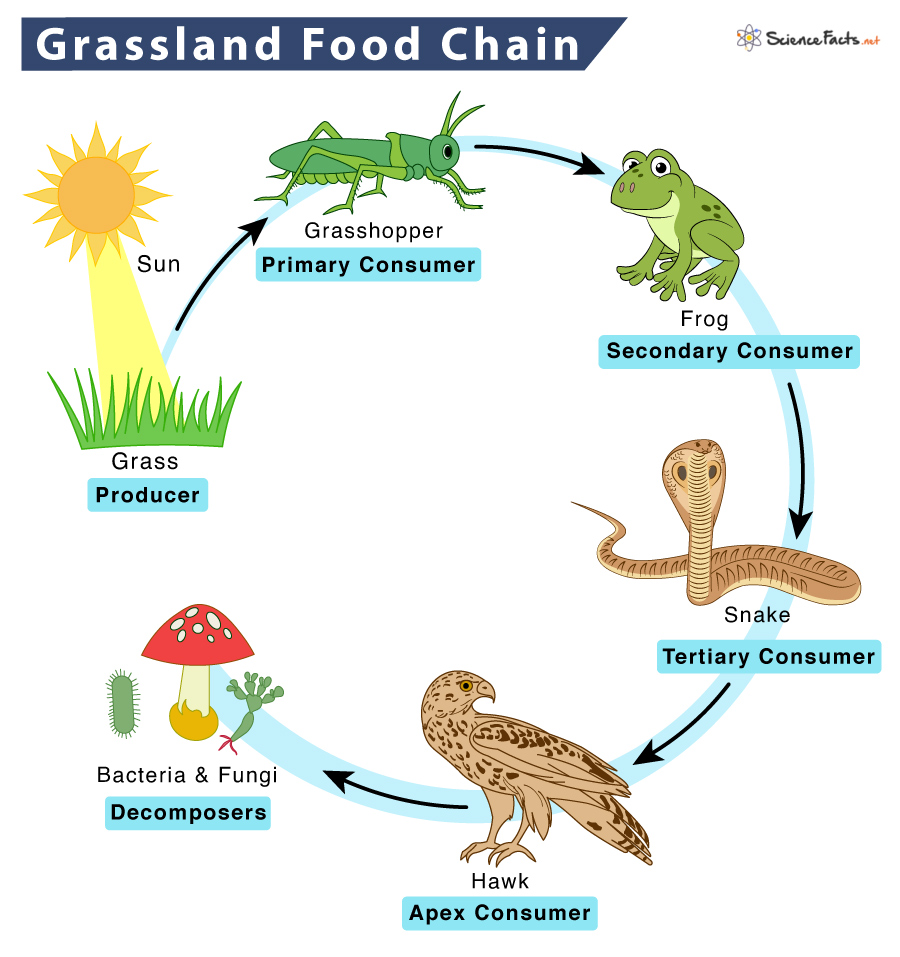Topic abiotic in ecosystem: Explore the pivotal role of abiotic factors in ecosystems, from regulating climates to shaping biodiversity, and discover their undeniable influence on the natural world.
Table of Content
- What are examples of abiotic factors in an ecosystem?
- Overview of Abiotic Factors
- Role of Temperature and Climate
- Importance of Water and Hydration
- Influence of Sunlight and Photoperiod
- Soil Composition and Terrain
- Air Quality and Atmospheric Gases
- YOUTUBE: Abiotic Factors in Ecosystems: Water
- Impact of Salinity in Aquatic Ecosystems
- Chemical Nutrients and Minerals
- Abiotic Stressors and Ecosystem Health
- Human Impact on Abiotic Factors
- Adaptations to Abiotic Conditions
What are examples of abiotic factors in an ecosystem?
Examples of abiotic factors in an ecosystem include:
- Temperature
- Light intensity
- Wind speed
- Rainfall
- Humidity
- Soil pH
- Topography
- Air composition
- Water availability
- Nutrient levels
- Salinity
- Oxygen levels
READ MORE:
Overview of Abiotic Factors
Abiotic factors are non-living components that play a key role in shaping ecosystems. They directly influence the survival, growth, and reproduction of living organisms. Understanding these elements is crucial for grasping how ecosystems function and maintain balance.
- Temperature: Affects metabolic rates and distribution of organisms.
- Light: Provides energy for photosynthesis, influencing plant growth patterns.
- Water: Essential for all life forms, influencing species distribution based on availability.
- Soil: Determines the types of plants that can grow, affecting the entire food web.
- Wind: Impacts plant morphology, pollination processes, and microclimate conditions.
- pH Levels: Influences nutrient availability and organism survival in both soil and water.
- Salinity: Critical in aquatic ecosystems, affecting the diversity of marine and freshwater species.
These factors are interconnected, with changes in one abiotic element potentially altering the entire ecosystem. Recognizing their interplay is vital for environmental conservation and management efforts.

Role of Temperature and Climate
Temperature and climate are critical abiotic factors that profoundly influence ecosystem dynamics. They dictate the distribution of species, seasonal behaviors, and survival strategies in various environments.
- Temperature Regulation: Determines the geographical distribution of organisms by affecting their metabolic and physiological processes.
- Seasonal Variations: Trigger behavioral adaptations in species, such as migration, hibernation, and breeding cycles.
- Climate Zones: Shape the characteristics of biomes, from tropical rainforests to arctic tundras, each supporting distinct communities of life.
- Global Climate Change: Poses challenges to ecosystems through rising temperatures, altering precipitation patterns, and increasing frequency of extreme weather events.
- Adaptation Mechanisms: Species evolve over time to cope with their climate, through physiological, morphological, and behavioral adaptations.
Understanding the role of temperature and climate is essential for predicting changes in biodiversity, ecosystem services, and the global distribution of habitats in response to climate change.
Importance of Water and Hydration
Water is a fundamental abiotic factor that sustains life, influences ecosystems, and shapes the physical landscape. Its availability and quality are vital for the hydration and survival of all organisms, driving biodiversity and productivity in habitats.
- Life Sustenance: Water is essential for cellular processes, including nutrient absorption, waste removal, and photosynthesis in plants.
- Habitat Formation: Bodies of water such as rivers, lakes, and oceans create diverse habitats that support aquatic and terrestrial life forms.
- Climate Regulation: Water bodies and moisture in the atmosphere play significant roles in regulating global and local climates.
- Soil Moisture: Influences plant growth and the distribution of terrestrial ecosystems by affecting soil composition and fertility.
- Water Cycle: The continuous movement of water through evaporation, condensation, precipitation, and runoff supports ecological balance.
Recognizing the importance of water and hydration underscores the need for conservation efforts to protect water resources and maintain ecosystem health in the face of environmental changes.

Influence of Sunlight and Photoperiod
Sunlight and photoperiod, the duration of daylight in 24 hours, are critical abiotic factors that drive many aspects of ecosystem function and biological rhythms. They not only provide the energy necessary for photosynthesis but also cue many life processes in organisms.
- Photosynthesis: Sunlight is the primary energy source for photosynthesis, enabling plants to produce oxygen and organic compounds that sustain most life forms.
- Seasonal Cycles: Changes in photoperiod regulate seasonal behaviors in organisms, such as flowering in plants, migration in birds, and hibernation in mammals.
- Energy Distribution: The intensity and duration of sunlight affect temperature and climate patterns, influencing ecosystem productivity and species distribution.
- Circadian Rhythms: Sunlight regulates biological clocks, impacting the daily activity patterns of both nocturnal and diurnal species.
- Ecological Niches: Variation in sunlight penetration, due to factors like canopy cover, shapes the habitat and niche availability within ecosystems.
The influence of sunlight and photoperiod is profound, orchestrating a wide range of ecological and evolutionary processes that underpin the diversity and stability of ecosystems.
Soil Composition and Terrain
Soil composition and terrain are pivotal abiotic factors that determine the structure and function of ecosystems. They influence water drainage, nutrient availability, and the types of plant and animal species that can inhabit an area.
- Soil Types: Varying in texture, pH, and organic matter content, different soils support diverse plant communities and agricultural practices.
- Nutrient Cycling: Soil is a major reservoir for nutrients essential for plant growth, such as nitrogen, phosphorus, and potassium.
- Water Retention: Soil composition affects its ability to hold water, influencing plant hydration and the availability of water for organisms.
- Terrain Features: Elevation, slope, and aspect affect sunlight exposure, temperature, and moisture, shaping ecological zones and biodiversity.
- Erosion and Deposition: The movement of soil by water or wind can significantly alter landscapes, affecting ecosystem development and habitat availability.
Understanding soil composition and terrain is crucial for conservation efforts, agricultural management, and predicting the impacts of climate change on ecosystems.
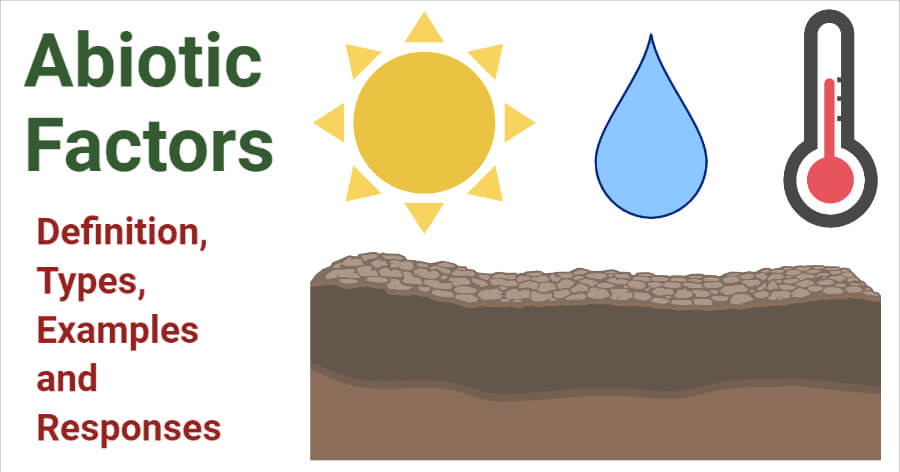
Air Quality and Atmospheric Gases
Air quality and the composition of atmospheric gases are critical abiotic factors that affect the health of ecosystems and the organisms within them. These elements play key roles in climate regulation, photosynthesis, and respiration.
- Oxygen: Essential for respiration in animals and plants, its concentration in the atmosphere supports life on Earth.
- Carbon Dioxide: A vital component for photosynthesis, its levels also influence global climate through the greenhouse effect.
- Nitrogen: Makes up a significant portion of the atmosphere; nitrogen fixation is crucial for plant growth and ecosystem productivity.
- Air Pollutants: Substances like ozone, nitrogen oxides, and particulate matter can harm living organisms and disrupt ecosystem processes.
- Climate Change: Increases in greenhouse gases, such as methane and carbon dioxide, contribute to global warming and climate variability.
The balance of atmospheric gases and air quality is essential for sustaining ecosystems. Monitoring and managing air pollution are crucial for protecting environmental health and biodiversity.
Abiotic Factors in Ecosystems: Water
\"Discover the captivating world of water in this mesmerizing video! Immerse yourself in breathtaking footage of serene oceans, powerful waterfalls, and peaceful rivers. Learn about the importance of water in sustaining life and uncover its hidden secrets in this educational and awe-inspiring journey.\"
Abiotic Factors in Ecosystems: Soil and Minerals
\"Unearth the wonders beneath our feet with this fascinating video on soil and minerals! Witness the incredible diversity of soils around the world, from rich, fertile earth to arid deserts. Delve into the intricate processes of mineral formation and understand their vital role in sustaining ecosystems. Get ready to be amazed by the hidden treasures of the Earth!\"
Impact of Salinity in Aquatic Ecosystems
Salinity, the concentration of salts in water, is a crucial abiotic factor that influences the diversity, distribution, and functions of aquatic ecosystems. It shapes the life forms that can thrive in different aquatic environments, from freshwaters to estuaries and oceans.
- Freshwater Ecosystems: Low salinity levels support species adapted to minimal salt environments, influencing species composition and biodiversity.
- Marine Ecosystems: Higher salinity in oceans supports a different set of flora and fauna, including many species of fish, invertebrates, and seaweeds.
- Estuaries and Brackish Waters: Fluctuating salinity levels in these areas create unique habitats that support diverse and productive communities.
- Osmoregulation: Organisms in aquatic ecosystems have developed various physiological adaptations to manage the effects of salinity on their water balance.
- Human Impact: Activities such as salt mining, irrigation, and freshwater diversion can alter salinity levels, potentially disrupting aquatic ecosystems.
The impact of salinity on aquatic ecosystems underscores the importance of maintaining natural salinity regimes to protect biodiversity and ecosystem health.

Chemical Nutrients and Minerals
Chemical nutrients and minerals are foundational abiotic factors that fuel the growth, development, and survival of ecosystems. They are integral to soil fertility, plant nutrition, and the overall productivity of ecosystems.
- Nitrogen and Phosphorus: Key components of DNA and ATP, crucial for plant growth and energy transfer within ecosystems.
- Potassium, Calcium, and Magnesium: Essential for plant structural strength, photosynthesis, and enzyme activation.
- Trace Elements: Iron, manganese, zinc, and copper are vital in smaller amounts for various biological functions, including chlorophyll production and nitrogen fixation.
- Soil Fertility: The availability of these nutrients in the soil affects the types and abundance of plant species, which in turn influences the entire food web.
- Nutrient Cycling: Decomposition of organic matter recycles nutrients back into the soil, making them available for plant uptake and sustaining ecosystem productivity.
Managing chemical nutrients and minerals through sustainable practices is crucial for maintaining ecosystem health and preventing nutrient depletion or toxic accumulations.
Abiotic Stressors and Ecosystem Health
Abiotic stressors, such as extreme temperatures, drought, flooding, and pollution, can have profound impacts on ecosystem health. Understanding these stressors is essential for mitigating their effects and promoting resilience in ecosystems.
- Extreme Temperatures: Can lead to heat stress in plants and animals, affecting growth, reproduction, and survival rates.
- Drought: Reduces water availability, stressing terrestrial and aquatic habitats, and leading to declines in biodiversity.
- Flooding: Alters habitats, displaces species, and impacts nutrient cycling and soil composition.
- Pollution: Toxic substances from industrial, agricultural, and urban sources can degrade habitats and harm wildlife.
- Salinity Changes: Affect water uptake in plants and can lead to habitat loss for freshwater species.
- Soil Erosion: Reduces soil fertility and can lead to the loss of habitats and agricultural land.
Mitigating abiotic stressors through conservation efforts, sustainable resource management, and policy interventions is crucial for the health and sustainability of ecosystems globally.

Human Impact on Abiotic Factors
Human activities significantly impact abiotic factors, affecting ecosystem balance and health. Understanding these impacts is crucial for developing strategies to mitigate negative effects and promote environmental sustainability.
- Climate Change: Emissions of greenhouse gases from fossil fuel combustion alter global temperatures and weather patterns.
- Pollution: Releases of chemicals and waste into the air, water, and soil degrade quality and harm organisms.
- Land Use Changes: Deforestation, urbanization, and agriculture alter landscapes, reducing natural habitats and biodiversity.
- Water Withdrawal: Excessive use of freshwater resources for industrial, agricultural, and domestic purposes lowers water tables and affects ecosystems.
- Soil Degradation: Practices like overgrazing, monoculture planting, and excessive use of chemicals reduce soil fertility and increase erosion.
- Resource Extraction: Mining and drilling disrupt soil structure, water regimes, and local ecosystems.
Proactive measures, including conservation, sustainable resource management, and environmental protection policies, are essential to reduce human impact on abiotic factors and safeguard ecosystem health.
READ MORE:
Adaptations to Abiotic Conditions
Organisms have evolved a myriad of adaptations to survive under various abiotic conditions, ensuring their survival and reproduction within specific ecosystems. These adaptations are critical for coping with challenges posed by non-living environmental factors.
- Thermal Adaptation: Species in extreme temperatures develop insulating features, like fur or fat layers, or mechanisms to dissipate heat.
- Water Conservation: Desert plants and animals exhibit adaptations like waxy plant surfaces or concentrated urine to minimize water loss.
- Salt Tolerance: Coastal and marine organisms possess physiological adaptations to manage high salinity levels, ensuring osmotic balance.
- Light Utilization: Plants in dense forests or deep-sea environments adapt to low light conditions with specialized photosynthetic strategies.
- Soil Preference: Certain plants have adapted to thrive in specific soil types, with root systems or leaf structures that optimize nutrient uptake.
- Wind Resistance: Flora and fauna in windy environments may develop streamlined bodies or flexible stems to withstand strong winds.
These adaptations not only illustrate the resilience and versatility of life but also highlight the intricate connections between organisms and their abiotic environment.
Exploring abiotic factors reveals the intricate balance of ecosystems, showcasing the resilience of life amidst diverse conditions. Embracing this knowledge empowers us to protect and sustain the natural world for future generations.
